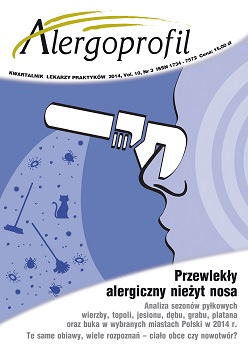Czy grypa jest możliwym czynnikiem broni biologicznej? Część II
##plugins.themes.bootstrap3.article.main##
Abstrakt
Współcześnie zagrożenie użyciem broni biologicznej staje się coraz bardziej realne. Z tego powodu znajomość obecnego stanu wiedzy w zakresie wczesnego rozpoznawania czynników broni biologicznej, w tym również grypy, a następnie możliwości skutecznego prowadzenia analiz wirusologicznych staje się koniecznością dla diagnostów laboratoryjnych, lekarzy wszystkich specjalności i pielęgniarek oraz przyszłych adeptów tych zawodów. Plany zapobiegania następstwom potencjalnego ataku biologicznego mogą się opierać jedynie na interpretacji i ekstrapolacji danych hipotetycznych, doświadczalnych lub zdarzeń z przeszłości. Przygotowanie się do tego zagrożenia, które może, ale nie musi, nastąpić, wymaga ugruntowanej wiedzy o czynniku sprawczym. Rozpylenie takiego czynnika sprawczego w formie aerozolu uznaje się za szczególnie niebezpieczne działanie w wojnie biologicznej, ponieważ stanowi ono zagrożenie dla dużych populacji ludzi. Obiektami hipotetycznego ataku mogą być miejsca o szczególnym zagęszczeniu mieszkańców. Newralgicznymi miejscami do przeprowadzenia ataku z użyciem aerozoli biologicznych są wysoce zurbanizowane tereny z wydajnymi systemami klimatyzacyjnymi (budynkami użytku publicznego i stacjami metra). Pracę pod tym samym tytułem w formie ustnej prezentacji przedstawiono 25–26 października 2013 r. na międzynarodowej konferencji „Advances in Pneumology” w Kassel (Niemcy) [1].
Pobrania
##plugins.themes.bootstrap3.article.details##
Copyright: © Medical Education sp. z o.o. This is an Open Access article distributed under the terms of the Attribution-NonCommercial 4.0 International (CC BY-NC 4.0). License (https://creativecommons.org/licenses/by-nc/4.0/), allowing third parties to copy and redistribute the material in any medium or format and to remix, transform, and build upon the material, provided the original work is properly cited and states its license.
Address reprint requests to: Medical Education, Marcin Kuźma (marcin.kuzma@mededu.pl)
Bibliografia
2. Daniszewski P. Bioterrorism – a threat to regional and global security. International Letters of Social and Humanistic Sciences 2013, 1: 28-34.
3. Plusa T, Jahnz-Rozyk K. Biological weapons: threat and prevention. Medpress, Warsaw 2002: 1-132.
4. Schoch-Spana M. Implications of pandemic influenza for bioterrorism response. Clinical Infectious Diseases 2000, 31: 1409-13.
5. Czuba K, Mazurkiewicz M, Kamiński K et al.: Bioterrorism – threat, rules of conduct, legal regulations. Bulletin from the Faculty of Pharmacy, Medical University of Warsaw 2011, 2: 28-33 [online: http://biuletynfarmacji.wum.edu.pl].
6. Krug RM. The potential use of the influenza virus as an agent for bioterrorism. Antiviral Research 2003, 57: 147-150.
7. Bartoszcze M, Kocik J. Selected problems regarding protection against bioterrorism. Military Pharmacy and Medicine 2009, 2(3): 19-22.
8. Drzewiecki A. Effective influenza prophylaxis. Infections 2008, 5: 50-53 [in Polish].
9. Denys A. Severe viral infections of the respiratory tract. Int Rev Allergol Clin Immunol Family Med 2013, 19(1): 24-28.
10. Public health response to biological and chemical weapons. WHO guidance. Second edition of health aspects of chemical and biological weapons: reports of a WHO Group of Consultants. WHO 2004, 1-328.
11. Madjid M, Lillibrdge S, Mirhaji P et al.: Influenza as a bioweapon. Journal of the Royal Society of Medicine 2003, 96: 345-346.
12. Woodard JL, Bray BS, Williams D et al. Call to action: integrating student pharmacist, faculty, and pharmacy practitioners into emergency preparedness and response. J Am Pharm Assoc 2010, 50: 158-164.
13. Pappas G, Panagopoulou P, Akritidis N. Reclassifying bioterrorism risk: are we preparing for the proper pathogens? J Infect Public Health 2009, 2: 55-61.
14. Brydak LB. Influenza, pandemic flu: myth or real threat? Rhythm, Warsaw 2008, 1-492 [in Polish].
15. Bhavsar TR, Kim HJ, Yu Y. Roles and contributions of pharmacists in regulatory affairs at the Center for Disease Control and Prevention for public health emergency preparedness and response. J Am Pharm Assoc 2010, 50: 165-168.
16. Russell C, Fonville JM, Brown AE et al. The potential for respiratory droplet-transmissible A/H5N1 influenza virus to evolve in a mammalian host. Science 2012, 336: 1541-1547.
17. [online: http://wakenews.net/html/jane_burgermeister.html"http://wakenews.net/html/jane_burgermeister.html].
18. [online: http://birdflu666.wordpress.com/2009/04 ].

